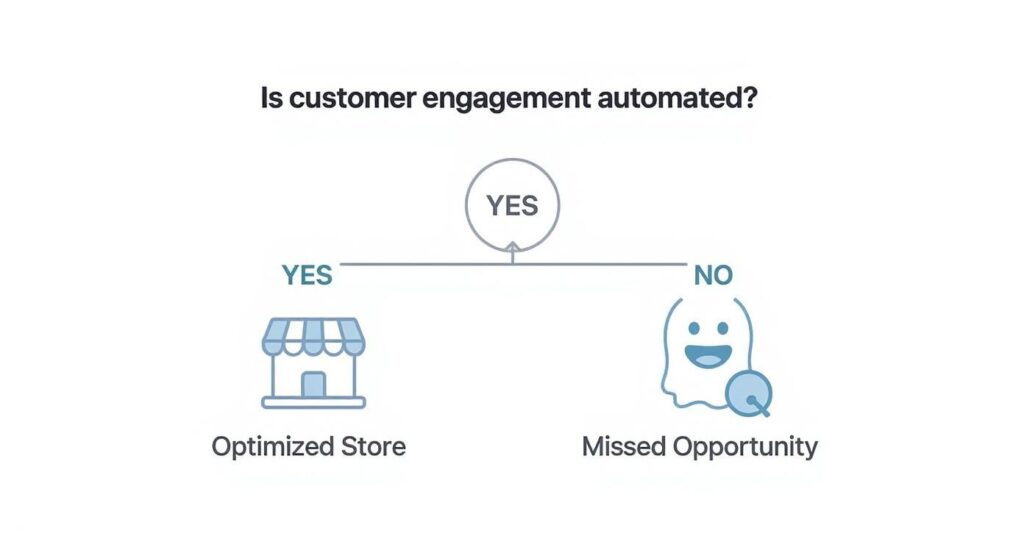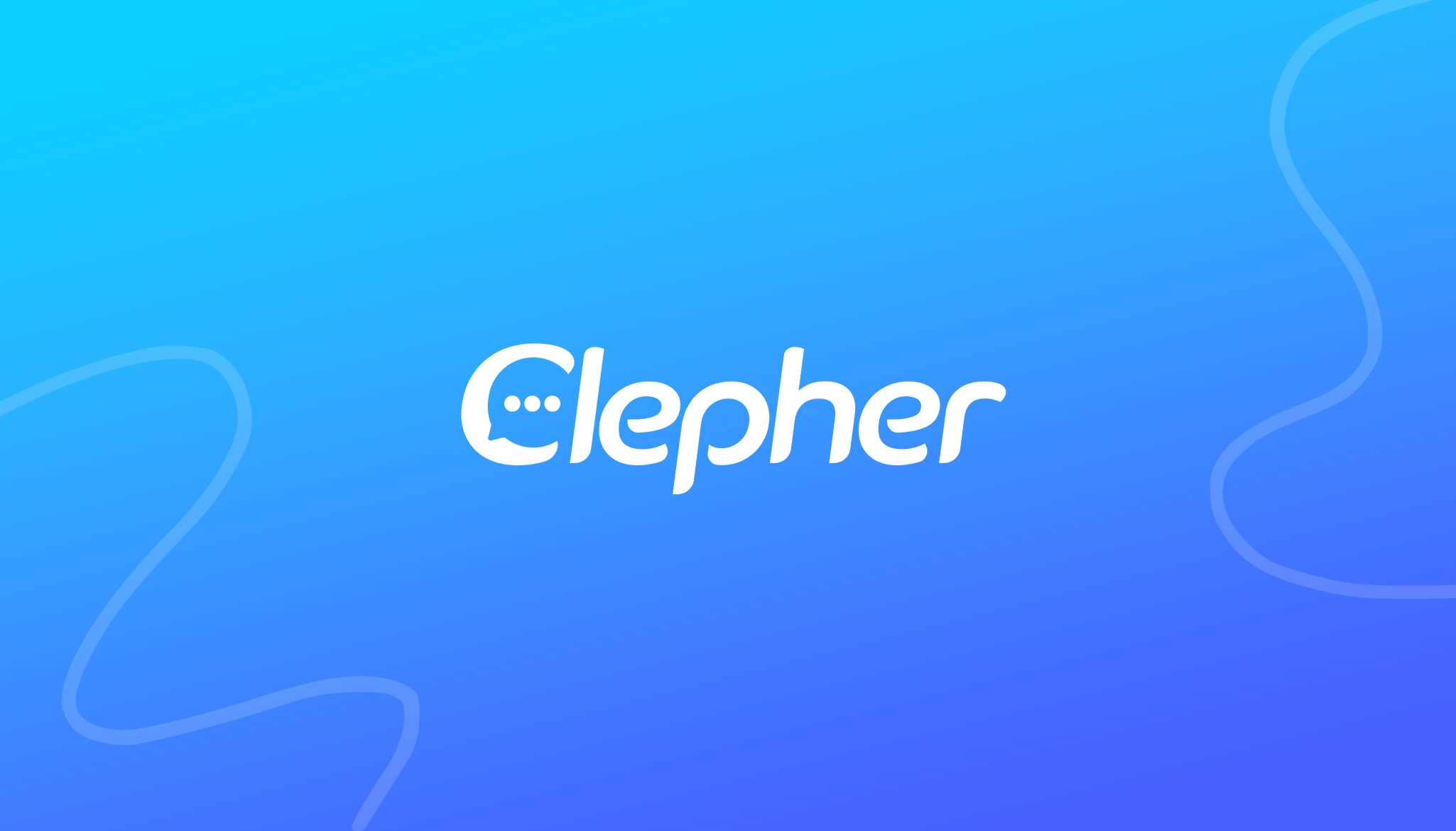Think of a chatbot for e-commerce as your store’s best employee. It works 24/7, never calls in sick, and knows your product catalog inside and out. Powered by ecommerce AI, this digital assistant engages customers in real time, answers their questions, and guides them smoothly from browsing to buying.
When built on a conversational AI platform, your chatbot becomes more than just a support tool—it becomes an intelligent sales partner that understands context, adapts to each shopper’s needs, and delivers a seamless, human-like experience. It’s the key to turning a quiet, passive website into a lively, conversational storefront that’s always ready to sell.
The New Storefront: How Chatbots Are Changing Ecommerce
What if you opened a physical shop, unlocked the doors, and then just… left? No staff, no one to greet customers, nobody to help them find what they’re looking for. People would wander in, get confused, and walk right back out, probably never to return.
That’s exactly what most ecommerce stores are doing every single day. They’re leaving potential sales on the table because there’s no one there to help.
A chatbot for ecommerce changes this entire dynamic. It’s not just another plugin; it’s your store’s most reliable team member. Powered by conversational AI and artificial intelligence, it acts as the friendly face at the door, the expert assistant who can point shoppers in the right direction, and the patient support agent ready to help at 3 AM.
From Passive Browsing to Active Engagement
Modern shoppers are impatient. They don’t have time to sift through endless FAQ pages or wait a day for an email response. They want answers now, just like they’d get from a helpful associate in a real-world store.
This is where chatbot solutions flip the script. Instead of making customers do all the work, a chatbot starts a conversation.
It’s a personal shopper:
“Looking for running shoes? Awesome. Are you training for a marathon or just need something for casual jogs?”
It’s a 24/7 support agent:
“Need to check on your order? No problem, just pop your order number in here.”
It’s a proactive sales assistant:
“Hey, I see you’re checking out our new coffee makers. We’ve got a bundle deal today that comes with a free grinder. Want to see it?”
By shifting from a monologue (the website talking at the customer) to a dialogue, AI agents make online shopping feel more human, helpful, and efficient. They solve the biggest problem with online stores: the lack of personal connection.
Meeting Modern Customer Expectations
This conversational approach isn’t just a gimmick; it gets real results. Studies show that 67% of millennials are more likely to buy from a brand that offers a chatbot. Why? Because it’s fast, convenient, and meets them where they are—whether that’s on your website or through Facebook Messenger.
A static website just sits there, waiting for the customer to make a move. A chatbot can help by anticipating needs, answering questions before they become deal-breakers, and stopping cart abandonment in its tracks. In a crowded market, this kind of proactive, instant engagement is what builds real customer loyalty and drives sales.
Understanding Your Ecommerce Chatbot Options
Choosing an ecommerce chatbot is like hiring a new team member. Are you looking for someone who just follows a script, or someone who can think on their feet? They aren’t all built the same, and understanding the core differences is your first step to finding the right fit for your online store.
Today’s best ecommerce chatbots go beyond basic scripts—they use ecommerce AI to understand context, recommend products, and deliver seamless omnichannel support across web, mobile, and messaging platforms.
This visual breaks down exactly what’s at stake—are you seizing the opportunity, or missing out?

ecommerce chatbot options
This decision tree cuts right to the chase: stores that automate engagement are set up for growth. Those that don’t risk becoming invisible to customers who need help right now.
Rule-Based Chatbots: The Reliable Script-Follower
Think of a rule-based chatbot as an interactive FAQ. It operates on a strict set of predefined rules and decision-tree logic that you create. The conversation is predictable, following a path of buttons and keywords you’ve already mapped out.
For example, a customer clicks “Track My Order,” and the bot immediately asks for an order number. It’s perfect for simple, repetitive tasks where you know exactly what the customer will ask.
- How it works: Pure “if/then” logic. If a user clicks “Returns,” then the bot shows the return policy.
- Best for: Handling high-volume questions—order status, shipping info, and basic product queries.
- Limitation: It can’t go off-script. If a user types “my package is late,” the bot might get stuck if it only recognizes the keyword “track order.”
AI-Powered Chatbots: The Expert Salesperson
Now, imagine a chatbot that acts more like a seasoned salesperson. That’s an AI-powered chatbot. Instead of just following a script, it understands context, intent, and even customer sentiment. It learns from every conversation, getting smarter over time.
This is where tech like Natural Language Processing (NLP) comes in. NLP lets the bot understand what customers mean, not just the specific words they type. A customer could say, “where’s my stuff?” and the AI bot understands this is an order tracking request, just like a human would.
AI chatbots transform a rigid Q&A into a flexible, natural dialogue. They can handle unexpected questions, offer personalized recommendations, and manage complex issues without needing to escalate to a human agent.
This powerful capability is a huge reason the chatbot market is exploding. The global market is projected to grow substantially in the coming years, driven by the demand for smarter customer engagement. You can learn more about these powerful chatbot statistics and market trends.
A Head-to-Head Comparison
So, which chatbot is right for your ecommerce store? It comes down to your goals, your budget, and the complexity of your customer needs. Here’s a straightforward comparison.
Rule-Based vs AI-Powered Ecommerce Chatbots
| Feature | Rule-Based Chatbot | AI-Powered Chatbot |
|---|---|---|
| Technology | Follows a pre-programmed script or decision tree. | Uses AI and NLP to understand and interpret user intent. |
| Conversation | Structured and limited to specific commands and buttons. | Flexible, natural, and can handle complex queries. |
| Learning | Static; it only knows what you program into it. | Learns and improves from every customer interaction. |
| Best Use Case | Answering simple FAQs, tracking orders, basic lead capture. | Personalized shopping, cart recovery, complex support. |
| Setup Cost | Generally lower, with faster initial setup. | Higher initial investment and requires more data for training. |
Ultimately, a rule-based bot is a great starting point for handling basic questions. But if you’re looking to create truly personal, human-like experiences that drive sales and loyalty, an AI-powered chatbot is the clear winner.
How Chatbots Drive Revenue and Increase Conversions
An ecommerce chatbot is much more than a customer service tool—it’s a powerful sales engine. By shifting from static web pages to dynamic, one-on-one conversations, you directly impact critical metrics like conversion rates and average order value.
It’s like having a personal shopper for every visitor. Instead of leaving them to wander around, a chatbot proactively engages, guides, and helps them along the path from discovery to checkout. Let’s break down the practical ways they make this happen.

chatbots and revenue
Guide Uncertain Shoppers with Product Recommendations
Many visitors land on your store with a vague idea of what they want but get stuck trying to find the perfect option. This decision paralysis is a conversion killer. A chatbot cuts through that confusion by acting as a knowledgeable product expert.
With just a few simple questions, the bot can narrow down the catalog and present the ideal product.
- For a skincare brand: “Are you looking for a product to help with hydration, acne, or anti-aging?”
- For an electronics store: “Will you be using this laptop for gaming, work, or general browsing?”
This guided selling process removes friction and builds shopper confidence, leading them straight to a product that solves their problem. The result? Significantly improving conversions with chatbots by actively helping customers.
Recover Abandoned Carts with Timely Interventions
Cart abandonment is one of the biggest leaks in any sales funnel. Nearly 70% of online shopping carts are left behind. A chatbot acts as your first line of defense, stepping in at the exact moment a visitor is about to leave.
By triggering a conversation based on exit-intent, the bot can figure out what’s causing the hesitation.
“Hey, before you go! Did you have a question about shipping? I can offer you free shipping on this order if you complete your purchase in the next 10 minutes.”
That small, automated nudge can be the difference between a lost sale and a completed order. It tackles common roadblocks like shipping costs or technical glitches in real-time, pulling back revenue that would have otherwise vanished.
Intelligently Upsell and Cross-Sell to Boost AOV
Increasing your Average Order Value (AOV) is one of the quickest ways to grow revenue without more traffic. An ecommerce chatbot is the perfect tool for suggesting relevant add-ons at just the right moment.
Unlike annoying pop-ups, a chatbot’s suggestions feel natural and genuinely helpful.
- Upselling: “Great choice on the standard camera! For just $50 more, the Pro model includes a longer-lasting battery and a waterproof case. Would you like to upgrade?”
- Cross-selling: “I see you’ve added the hiking boots to your cart. Customers who bought these also loved our moisture-wicking wool socks. Want to add a pair?”
These targeted recommendations naturally increase the value of each transaction. It’s even more powerful when you integrate your chatbot into a broader automated sales outreach strategy, creating a seamless system for nurturing leads and driving consistent growth.
Streamlining Support and Building Customer Loyalty
While chatbots are great for sales, their real power lies in building lasting customer relationships that fuel long-term growth. This is where your chatbot becomes a trusted support pillar, turning operational headaches into five-star reviews and repeat business.
It all starts with providing instant, 24/7 answers to common questions like “Where is my order?” or “What’s your return policy?”—the exact queries that clog up your support inbox.

chatbots and support
Freeing Up Your Human Experts
Automating these simple questions provides two huge wins. First, customers get the immediate answers they crave. In fact, 64% of internet users say 24/7 support is a top chatbot benefit. No more waiting for an email reply—they get a solution in seconds.
Second, you free your human support team from repetitive tasks. Instead of resetting passwords all day, your agents can pour their expertise into complex, high-value conversations, like handling a sensitive complaint or walking a VIP customer through a tricky issue.
A chatbot doesn’t replace your support team; it empowers them. It acts as a first-line filter, resolving up to 80% of common issues instantly and escalating only the most nuanced problems to a human agent.
This setup makes for a more efficient workday and ensures that customers with urgent problems get the focused attention they need.
Gathering Feedback to Fuel Growth
A chatbot is also an incredibly powerful tool for gathering customer feedback. Right after a purchase or a support chat, the bot can pop up with a simple, non-intrusive question.
- “How would you rate your support experience today?”
- “On a scale of 1-10, how easy was it to find what you needed?”
- “Is there anything we could do to improve our checkout process?”
This real-time feedback loop gives you a constant stream of valuable insights. You can quickly pinpoint friction in the customer journey, spot recurring product issues, or uncover new ways to improve.
The Foundation of Customer Loyalty
When you get down to it, streamlining your operations with a chatbot directly impacts your bottom line. It saves time, cuts operational costs, and builds a reputation for outstanding service.
When customers know they can get fast, reliable help anytime, they start to trust your brand. That trust is the very foundation of customer loyalty. Dive deeper with our guide on improving customer support with chatbots for more detailed strategies.
Choosing the Right Ecommerce Chatbot Platform
With a flood of chatbot platforms on the market, picking the right one can feel overwhelming. But here’s the secret: it’s not about the flashiest features. A great chatbot should plug directly into your business, feel like a natural part of your brand, and be ready to grow right alongside you.
Making the right choice means you get a reliable partner that drives sales and makes your support team’s life easier. The wrong one leads to frustrated customers and wasted money.
Your Non-Negotiable Checklist
Before you commit, run any potential platform against these core essentials. Get these right, and you’re building a tool that will pay for itself over and over.
- Seamless Platform Integration: Your chatbot must connect effortlessly with your ecommerce platform, whether that’s Shopify, Magento, BigCommerce, or WooCommerce. This deep integration allows the bot to check order statuses, pull product info, and process refunds automatically.
- Deep Customization Options: A cookie-cutter chatbot makes your brand look generic. The right platform gives you control over everything from the chat widget’s colors to the bot’s tone of voice. You need a tool that can capture your brand’s personality, whether it’s quirky and fun or buttoned-up and professional.
- True Scalability: The chatbot you choose today needs to work for the business you’ll be in two years. Can it handle 10,000 conversations a month as easily as it handles 100? Look for a platform that won’t buckle under pressure as your traffic and product catalog expand.
Your chatbot is an extension of your brand. If it can’t integrate smoothly with your store, match your voice, or handle your future growth, it’s the wrong tool for the job.
The demand for these tools is exploding for a reason. You can find more powerful chatbot market statistics that show exactly where the industry is headed globally.
The Build vs. Buy Decision
Should you build a custom chatbot or buy a ready-made platform? For almost every ecommerce business, an off-the-shelf solution is the smarter, faster, and cheaper path.
Building a chatbot from scratch is a massive undertaking. It requires a dedicated developer team, a huge upfront investment, and endless maintenance. It’s a slow, expensive journey best left to massive enterprises.
Buying a platform like Clepher gets you up and running in a fraction of the time and cost. These no-code tools are built for ecommerce, packed with pre-built integrations and proven conversation flows. You can launch in days, not months, and get all future updates without lifting a finger.
For a closer look at the best options out there, check out our guide on the 5 best chatbots for ecommerce in 2024.
Best Practices for a Successful Chatbot Launch
Launching an ecommerce chatbot isn’t as simple as flipping a switch. If you want to turn that chat widget into a genuine business asset, you need a plan. Success comes from a smart cycle of planning, thoughtful design, and continuous improvement.
These are the ground rules for creating a chatbot that actively helps customers and pushes your business forward. Get the clarity, personality, and user experience right, and your bot will become an essential part of your store.
Define One Clear Goal
The biggest mistake is trying to have your chatbot do everything at once. This “jack of all trades” approach usually ends in a confusing, frustrating experience. Start with a single, laser-focused goal.
Do This: Start with one high-impact goal, like, “Cut down our ‘Where is my order?’ support tickets by 50%.
Avoid This: Building a bot that tries to track orders, give styling advice, tell jokes, and capture leads all at the same time.
Once your bot has mastered its first job, you can start adding more skills. This step-by-step method ensures it does one thing exceptionally well before getting more complicated.
Craft a Consistent Brand Personality
Your chatbot is on the front lines, so its personality is non-negotiable. A generic, robotic tone feels unhelpful. Design your bot’s voice to match your brand’s character—whether that’s fun and informal or buttoned-up and professional.
- For a playful streetwear brand: “Yo! What’s up? Need help finding the freshest drops or tracking your gear?”
- For a luxury skincare line: “Welcome. How may we assist you today? Are you interested in product information or order support?”
Whatever you choose, be consistent. Your chatbot’s tone should align with your emails, social media, and website copy. This builds trust and makes the entire experience feel connected.
Always Provide an Escape Hatch
No matter how intelligent your bot is, it won’t have an answer for everything. There is nothing more infuriating for a customer than getting stuck with a bot and having no way to reach a person. You must provide a clear, easy way to escalate the conversation to a human.
This “escape hatch” is a deal-breaker. A simple button like “Talk to a person” can rescue a negative experience and show you’re serious about solving their problem.
Analyze and Refine Constantly
The work isn’t done after launch day. The best chatbots are always learning. Regularly dig into chat logs and customer feedback to see what’s working and what’s falling flat. A huge part of this is making sure your bot has the best information to work with by optimizing your own content—a practice known as Answer Engine Optimization (AEO).
Look for patterns. Are people constantly asking a question the bot can’t answer? Are they getting stuck in a specific conversation flow? Use those insights to train your chatbot, tweak responses, add new skills, and make your AI assistant smarter over time.
Frequently Asked Questions About Ecommerce Chatbots
Jumping into the world of ecommerce automation brings plenty of curiosity. Here’s what most store owners need to know about ecommerce chatbots before getting started.
Conclusion
In conclusion, implementing a chatbot for ecommerce can completely transform how online stores connect with customers. Powered by advanced AI capabilities, the best ecommerce chatbot doesn’t just answer questions — it engages visitors in real time, offers support when it’s needed most, and enhances the overall shopping experience.
By drawing from a robust knowledge base, these chatbots handle customer queries efficiently, ensuring every shopper receives fast, helpful assistance around the clock. Even better, when a chatbot can help recommend products based on browsing behavior or past purchases, it turns casual visitors into loyal buyers through personalized suggestions.
Businesses embracing conversational commerce and ecommerce bots are already seeing the impact — smoother customer journeys, higher conversion rates, and stronger digital marketing performance. And with many platforms offering a free trial or free plan, it’s easier than ever to get started and explore chatbot best practices before fully committing.
Ultimately, a well-designed chatbot does more than automate conversations — it collects valuable customer insights, helps businesses make smarter decisions, and drives measurable growth over time.
Ready to see how an AI-powered chatbot can transform your store’s sales and support? Clepher makes it easy to design, launch, and manage intelligent conversations on your website, Messenger, and Instagram—no coding required. Start building better customer relationships and recovering lost sales today. Get started with Clepher.
Related Posts



